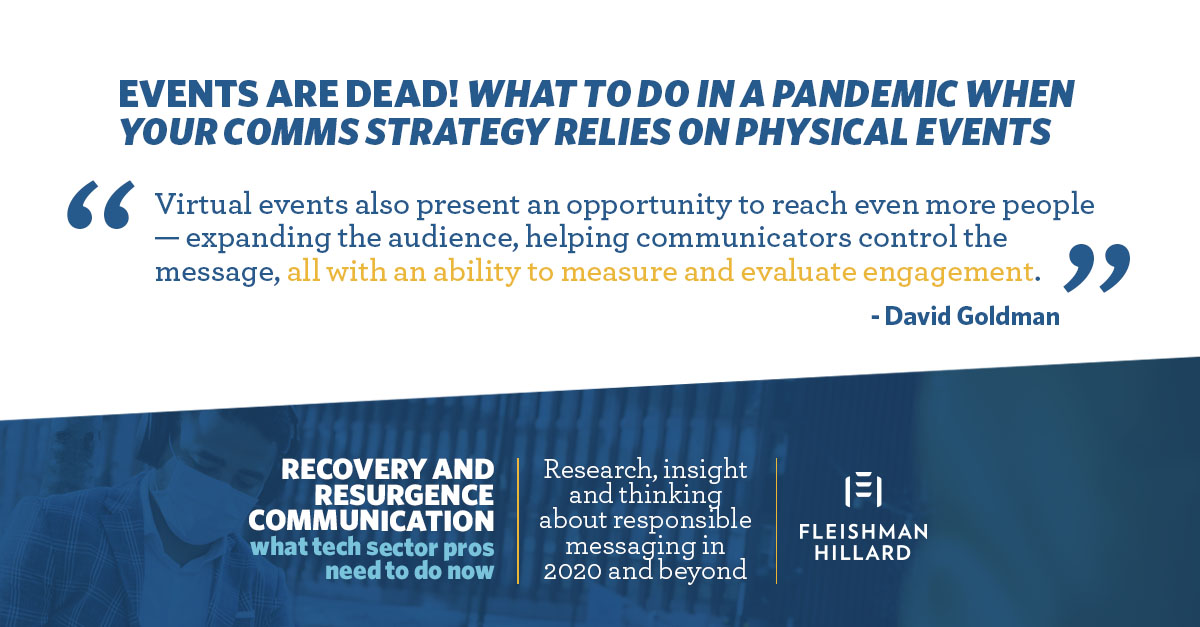Events Are Dead! What to Do in a Pandemic When Your Comms Strategy Relies on Physical Events
“The outbreak of COVID-19 has spelled doom for the global events market, with around $135 billion of the total economic output unlikely to be generated by the end of Q2 2020. The global events industry is likely to head toward a slowdown.” – Exhibition and Events Market — Global Outlook and Forecast 2020-2025
Events are dead … at least as we once knew them.
Will we miss them? Do you know anyone who truly enjoyed events? The cab lines, the cavernous convention halls with recycled air, the parades of briefings and hospitality events. Interview-packed days and sleepless nights writing, editing and posting stories.
What we sometimes forget is, it was never about the event. The best communications campaigns are just that, campaigns. A process of communication that begins well before an announcement and continues beyond it. The fleeting moment in time that is the event is only one part of a well-executed communications strategy. Conversations, briefings, thought leadership, sponsorships, websites, blogs, announcements and reviews all will continue, and events in some form will carry on as a critical element in the communication chain.
Virtualizing an event can have many benefits: you can still communicate what you planned to communicate IRL. You can own the moment without having to compete with other brands and activations IRL. You can execute the event whenever and for however long you want. You can extend the audience beyond IRL attendees. You can facilitate one-to-one interactions, deepen relationships, create memorable experiences and measure it all. Virtual events also present an opportunity to reach even more people — expanding the audience, helping communicators control the message, all with an ability to measure and evaluate engagement.
However, moving offline to online doesn’t mean events will require any less work or investment. In fact, they will be even more challenging and demand the development of new communications ‘muscle.’ When consumers, customers and journalists have been staring at their screens all day, communicators must over-rotate on creative content production and delivery strategies that really grab and hold attention.
As we pursue this new path of storytelling, we need to remember that all events are not the same. They never were, and taking them online doesn’t change that. Many consumer technology events have come to rely on the physical product demonstration or a hands-on experience with a product or service. Some are based upon the dissemination of information at scale or focused purely on relationship building. Others are intended to reach the media, designed for customers, or aimed at reaching the consumer directly. The needs of each of these audiences will still need to be satisfied to ensure the success of the event and ultimately the communications campaign and business objectives.
As we navigate our new normal and shift from offline to online, there are a number of mandates companies must consider to be successful:
The Right Partners
- Experience, creativity and dependability matter just as much in this new environment. Whether you’re exploring a content partner or technology platform partner/solution, make sure they share your company values and have the right experience to amplify and deliver success.
The Right Distribution Platform
- Make sure the technology solution being used caters to your needs. Does the software have a hard cap for participants, attendees and contributors? Do you need capability for surveys, live questions, chat? Do you need live editing, live graphic transitions? What kind of content do attendees need to see and/or interact with? Where do you hope for attendees to connect post-stream? Will you disseminate assets via mail or through a portal? Do you need a secondary breakaway channel for media to interact with stakeholders? Do you need to coordinate product delivery with an embargo? Not all platforms have recording functionality either. Working with the right partner to ask the right questions will help confirm the best platform for you.
- Communicators should also think more broadly. You could even take it to another level and produce a documentary or film as a way to convey new information.
A Creative Approach
- The best approach to events has always been through multitiered, multifaceted campaigns that build before and continue with a steady cadence after. This should not stop.
- Be COVID-19 conscious. Know your audience. Some will care most about the news you have, others will care more about the pandemic and how your news impacts or disregards the public’s health and/or economic impact.
- Consider themes — a talk show, news format or even a game show? Keep it engaging and appropriate.
- Embrace the new normal and the informal. We’re all at home (and many of us are in sweatpants). While brands should come across professional, always, it’s time to ‘loosen the tie’ or better yet, take it off completely. Connect with the audience in a way that feels relevant, timely and approachable.

